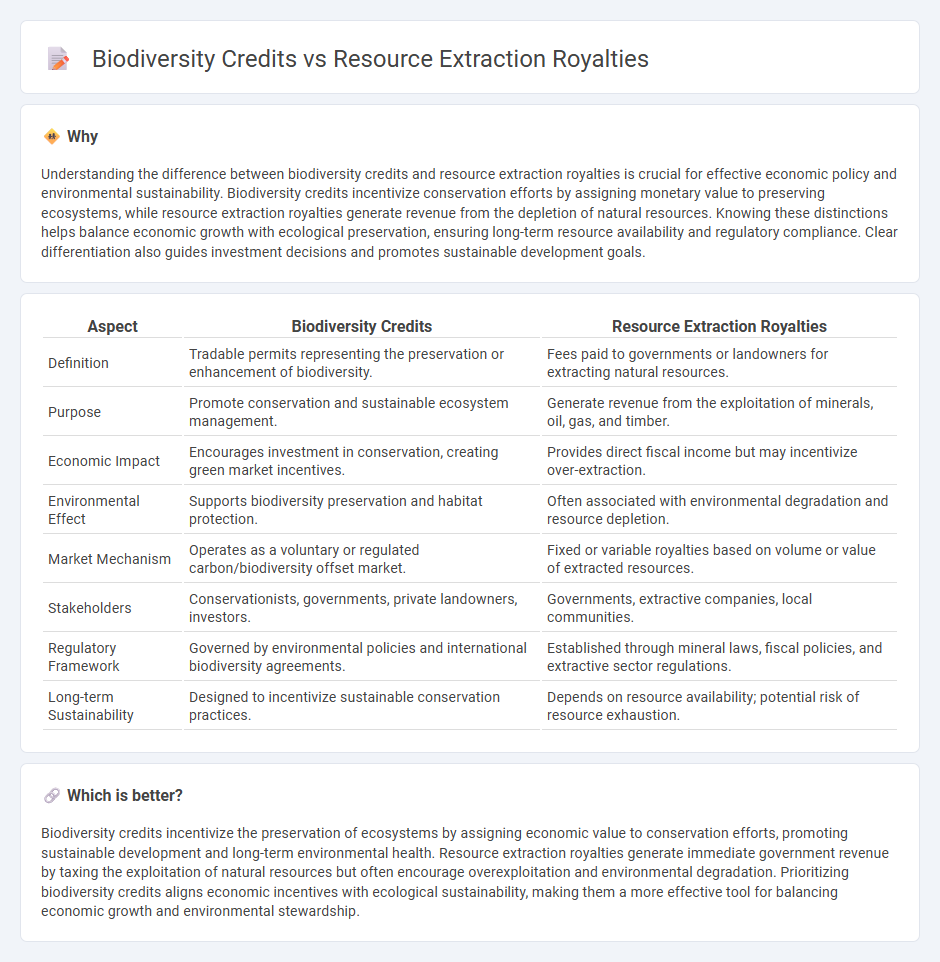
Biodiversity credits promote sustainable environmental investments by quantifying ecosystem preservation benefits, while resource extraction royalties generate government revenue from the exploitation of natural resources like minerals and fossil fuels. Balancing these approaches impacts economic growth and ecological conservation strategies. Explore how integrating biodiversity credits could reshape resource management and economic policies.
Why it is important
Understanding the difference between biodiversity credits and resource extraction royalties is crucial for effective economic policy and environmental sustainability. Biodiversity credits incentivize conservation efforts by assigning monetary value to preserving ecosystems, while resource extraction royalties generate revenue from the depletion of natural resources. Knowing these distinctions helps balance economic growth with ecological preservation, ensuring long-term resource availability and regulatory compliance. Clear differentiation also guides investment decisions and promotes sustainable development goals.
Comparison Table
| Aspect | Biodiversity Credits | Resource Extraction Royalties |
|---|---|---|
| Definition | Tradable permits representing the preservation or enhancement of biodiversity. | Fees paid to governments or landowners for extracting natural resources. |
| Purpose | Promote conservation and sustainable ecosystem management. | Generate revenue from the exploitation of minerals, oil, gas, and timber. |
| Economic Impact | Encourages investment in conservation, creating green market incentives. | Provides direct fiscal income but may incentivize over-extraction. |
| Environmental Effect | Supports biodiversity preservation and habitat protection. | Often associated with environmental degradation and resource depletion. |
| Market Mechanism | Operates as a voluntary or regulated carbon/biodiversity offset market. | Fixed or variable royalties based on volume or value of extracted resources. |
| Stakeholders | Conservationists, governments, private landowners, investors. | Governments, extractive companies, local communities. |
| Regulatory Framework | Governed by environmental policies and international biodiversity agreements. | Established through mineral laws, fiscal policies, and extractive sector regulations. |
| Long-term Sustainability | Designed to incentivize sustainable conservation practices. | Depends on resource availability; potential risk of resource exhaustion. |
Which is better?
Biodiversity credits incentivize the preservation of ecosystems by assigning economic value to conservation efforts, promoting sustainable development and long-term environmental health. Resource extraction royalties generate immediate government revenue by taxing the exploitation of natural resources but often encourage overexploitation and environmental degradation. Prioritizing biodiversity credits aligns economic incentives with ecological sustainability, making them a more effective tool for balancing economic growth and environmental stewardship.
Connection
Biodiversity credits monetize ecosystem conservation, creating financial incentives that complement resource extraction royalties by ensuring companies internalize environmental costs of natural resource use. Resource extraction royalties generate revenue based on the volume or value of extracted materials, while biodiversity credits promote sustainable practices by valuing conservation outcomes. Together, these mechanisms encourage responsible extraction and biodiversity preservation, aligning economic development with environmental sustainability.
Key Terms
Rent-seeking
Resource extraction royalties are payments made to governments or landowners for the right to extract minerals, oil, or other natural resources, often leading to rent-seeking behavior where entities attempt to capture economic rents without contributing to productive activities. Biodiversity credits, on the other hand, represent a market-based approach incentivizing conservation efforts by assigning value to ecological assets, potentially reducing rent-seeking by aligning economic incentives with environmental preservation. Explore how shifting from traditional royalties to biodiversity credits can mitigate rent-seeking and promote sustainable resource management.
Ecosystem services
Resource extraction royalties are payments made to governments or local communities based on the volume or value of extracted natural resources, directly linked to economic benefits but often neglecting environmental impacts. Biodiversity credits, a market-based tool for ecosystem services, incentivize conservation by assigning monetary value to the preservation and enhancement of biodiversity and ecosystem functions such as water filtration, carbon sequestration, and habitat provision. Explore how integrating these mechanisms can promote sustainable resource management and strengthen ecosystem service conservation.
Valuation mechanisms
Resource extraction royalties are typically calculated based on the volume or value of extracted materials, reflecting direct economic returns from natural resources. Biodiversity credits use market-based valuation mechanisms that quantify ecological benefits like species preservation and habitat restoration, often relying on ecological metrics and ecosystem services valuation. Explore further to understand how these distinct valuation approaches impact sustainable development and conservation goals.
Source and External Links
The Case for Royalties: Why Hardrock Mines on Federal Lands Must Pay Their Fair Share - Royalties are payments made to resource owners (often the public) for extracting minerals, ensuring economic fairness and environmental stewardship; unlike oil and gas, hardrock mining in the U.S. has paid virtually no royalties despite massive extraction and associated cleanup costs, making the U.S. an outlier compared to countries like Canada and Australia where such royalties fund public infrastructure and environmental restoration.
Revenues | How It Works - When companies extract natural resources from federal lands, they pay royalties--a percentage of the sales value of extracted resources--to the Department of the Interior, although for locatable hardrock minerals, companies pay fees instead of royalties due to the Mining Law of 1872; royalty payments are a major revenue source alongside bonuses, rents, and fees.
The Role of Royalties in Resource Extraction Contracts - Royalties in resource extraction contracts influence firms' production decisions and can be economically efficient by signaling the marginal impact of extraction on resource value, and they play a key role under conditions of uncertainty and asymmetric information between governments and extractors.
 dowidth.com
dowidth.com